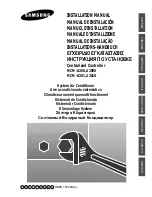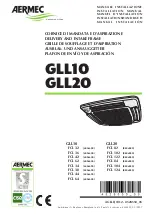
30
6. Observe sight glass (factory-installed) to see if system is filling with refrigerant for
normal refrigeration cycle.
7. If the Sight glass shows bubbles, more refrigerant may be required, while
allowing sufficient time for the refrigerant to stabilize and clear the Sight glass.
Use supplied information on the following pages for proper final charge.
BUBBLES IN THE SIGHT GLASS CAN BE CAUSED BY FLASHING DUE TO
PRESSURE DROP FROM PIPE OR ACCESSORY LOSSES, ETC.
Charging of Systems with Head Pressure Control in temperatures
below
70°F (21°C)
(After normal evacuation procedures):
1. You must power the condensing unit for up to 24hrs prior to charging the system
to allow the system to energize. This will allow the compressor
’s oil crankcase to
warm. If not done hours in advance of the system/compressor start-up, there is
risk of premature compressor failure, which would not be covered under
warranty.
2. Follow instructions 1 through 7 above.
3. If the valve setting is correct for the system being charged, it is quite likely some
refrigerant will be backed up into the condenser and the Sight glass will indicate
bubbles in the liquid line.
4. Add more refrigerant, while allowing sufficient time for the refrigerant to stabilize
and clear the Sight glass. Use supplied information on the following pages for
proper final charge.
5. At this point the system is correctly charged for this type of head pressure control
at the ambient temperature that exists while the charging procedure is taking
place.
6. If the system is designed to operate at ambient below the ambient that exits
during charging, additional charge may have to be added now.
Good system performance during low ambient operation depends on proper refrigerant
charge; therefore, it is very important that this phase of the installation procedure be
done carefully. Poor system performance is often caused by over- or under-charging of
refrigerant and may be the most overlooked.
With the system started
•
After following instructions on the previous page Charging for Systems with Head
Pressure Control, with refrigerant tank now connected to suction line (low side) port to
add remaining charge in a gas state, refer to the provided charts for proper system
operating points as equated to ambient temperature with wine cellar at normal
conditions of 57°F (13°C) / 55%RH. Refer to Split Systems Operations chart on page
49 for system pressures, subcooling, and superheat values to allow you to charge
your system correctly.
•
In addition to using the Systems Operations Chart, there is a liquid line moisture/sight
glass located in the condensing (outdoor) unit as a useful guide to help determine if
Summary of Contents for 99H0204-20
Page 12: ...12 Overview of the Evaporator Fig 1...
Page 14: ...14 Overview of the Condenser Fig 2...
Page 15: ...15 Refrigeration Illustration Fig 3...
Page 16: ...16 Wiring Diagram for SP25 Fig 4 DS025 Condenser...
Page 18: ...18...
Page 19: ...19 Specifications Wine Guardian Specification Sheet 60Hz models...













































